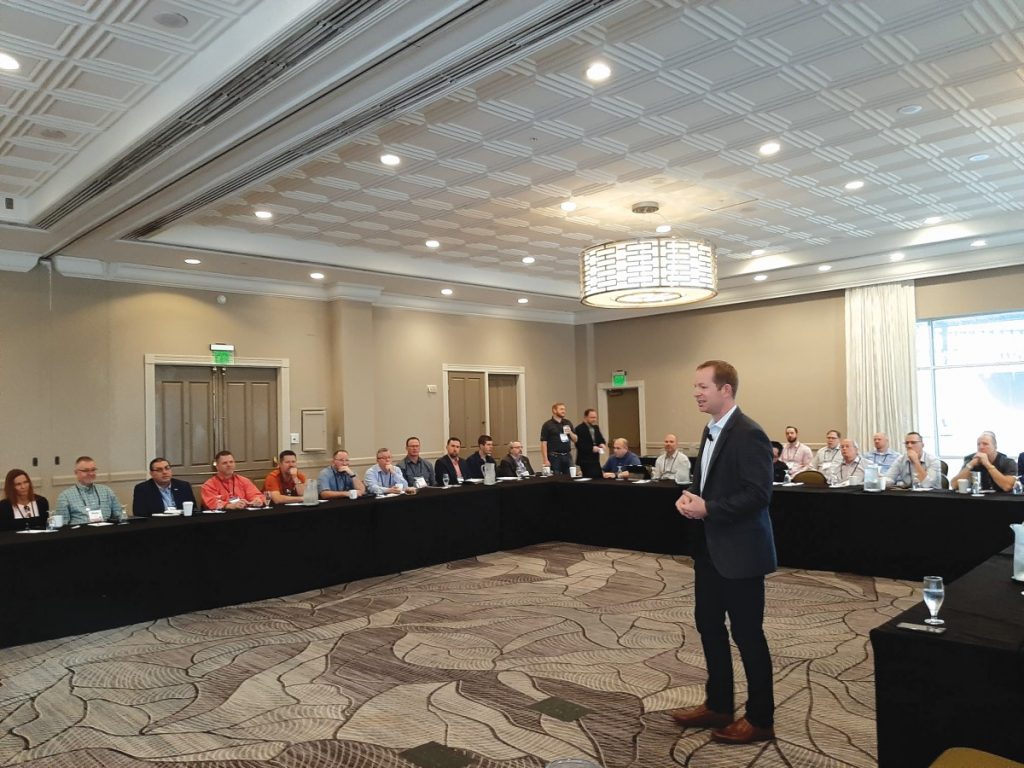Exec Interview: The Future of Mercury Security
Mercury leaders discuss the brand’s status under HID Global, unveil its roadmap, survey the competitive landscape and address a leap-year glitch.

Already the industry’s leading OEM supplier of open access control boards, Mercury now has even more muscle thanks to an infusion of might from new owner HID Global.
Mercury is the warmest planet in our solar system and also the hottest recent brand addition to access control pacesetter HID Global’s galaxy. Having acquired Mercury Security — the electronic access industry’s leading OEM supplier of open platform control boards — in October 2017, the 1992-founded business is now one of HID’s flagship brands.
There is said to be more than four million Mercury boards controlling electronic access systems worldwide.
“Mercury Security as a business doesn’t exist anymore. The Mercury product line is a brand within HID Global that also includes the VertX and forthcoming Aero controllers,” says former Mercury Security President Matthew Barnette, now serving as vice president – Global Accounts, Mercury, PIV for HID Global Physical Access Control Solutions. “HID is investing significantly in the team at our Long Beach [Calif.] headquarters and we’ve taken on additional controller work. The investment is not only in engineering but also in areas like our sales organization.”

SSI recently seized the opportunity to attend the sixth annual MercTech summit event that brings together several of Mercury’s top OEM partners (see page 2) and specifying security consultants. Connected to that event, Barnette and Steve Lucas, vice president, sales and marketing, Mercury, Aero, VertX & Edge for HID Global Physical Access Control Solutions, shared thoughts on vision for the brand, open platform advantages and how a firmware snafu was being remedied.
What are the most challenging aspects of your present positions?
Matt Barnette: Focusing this purely on the controller business is really twofold. How do we attract and retain the best employees? This is an incredibly tight job market in North America right now and we’re very engineering-based within Mercury Security. Attracting that talent as we continue to grow and retaining that talent, a lot of young engineers, is challenging. We do have the luxury of being close to a major university, so we get a lot of young engineers coming out of school. We groom them and raise them up through the Mercury career ladder, but we also have to make sure we can continue to engage with them and have this as a place they call home for a long time.
The other side of the coin is, as a product company in this new cyber-secure world we’re trying to live in, making sure the products we’re putting on networks around the world, to the best we can, do not let malicious attacks occur to our customers and their assets. That’s woven into the Mercury engineering’s philosophy.
Steve Lucas: For myself and my team, it’s about maintaining and attracting the top OEM partners to carry and drive our brand. If you look at Mercury’s business throughout its 20-plus year history, our success is entirely dependent on OEM partners taking our products to market and through their downstream integration partners. We seek best-in-class partners as needs change, technology changes and customer requirements change. Maintaining that right balance of great partners driving our product without oversaturating the customer base is a constant challenge. I also echo Matt’s comments on cybersecurity and its increased focus and scrutiny. It’s about ensuring we are on top of the latest standards and industry drivers. That could be cyber, Cloud or mobile, whatever trend might be emerging.
What have been the company’s most significant recent developments?
Barnette: We revamped and relaunched the entire product line starting in 2018. A lot of new capabilities in the products specific toward cybersecurity and making sure that this is a platform that can be built on for the next 10-plus years. With the average lifecycle of an access control system being 12-15 years, we wanted to ensure an integrator installing these products and customers buying them are able to get a long life out of them. We’ve added at the chip level for the boards enhancements to provide a higher resilience in the cyber world. One of the newer capabilities we’re at the forefront is the ability to modify the performance of the card reader that’s attached to the Mercury panel. We’ve had the functionality where you can download the firmware from the Mercury panel into the card readers from specific manufacturers that offer that capability. We’re now offering the ability to actually change the configuration of HID card readers through the panel. So integrators can do things like transitioning a customer from older prox technology with cards that can be easily cloned.
If a customer is transitioning their card population and they put in readers that have additional capabilities from prox to either iCLASS or prox, they can disable the prox capability at some point without having to go around to each individual reader. Otherwise it’s a very manual process requiring two people — somebody to cycle power to the reader while somebody else holds a configuration card at the reader. That’s a labor-intensive process. For the Mercury panel, it’s part of a foundational change that’s built-in that we’ll be expanding on for the foreseeable future.
Lucas: It was a pretty big investment and shift for us as a business where we’ve overhauled the entire product family from top to bottom. It’s the first time we had really done that since the mid-2000s. So you get a lot of improvements around the platform itself, improvements in processing and memory. Most importantly we put a heavy, heavy focus on cybersecurity as well as adherence to the current standards within the IT world. A lot of networking standards and other things the IT department likes to see on the devices that are on the wall.
Where that benefits the integrator is we have more than four million of our devices deployed around the world. When we designed this current generation of product, we designed it as a board form-fit replacement for the existing models in the field. We’re trying to make it very easy for those end customers to migrate, and from a labor standpoint, to make it very easy for those integrators to replace old with new. It’s the same size board, same installation method and the same connectors.
From three years ago until now, we’ve had a pretty sizeable expansion of the sales team. We now have dedicated business development folks in the U.S. and we have our most recent hire covering the Europe and EMEA markets. Not only are they focusing on our corporate relationships but they’re a resource available for the consultants and the integrators as it relates to all controller brands within HID. We’re really trying to get out into the field to help bridge any knowledge gap from Mercury down to the integrator level, and help them be more successful.

As it has been for the past few years, cybersecurity was a hot access control topic as Steve Lucas moderated a consultants roundtable during this year’s sixth annual MercTech summit event in Fort Myers, Fla.
In 2020, what goals would you like to accomplish; what will success look like?
Barnette: As a heavily engineering-driven company, we want to be responsive to what our customers are asking for in the product. So we’re increasing the pace and rhythm of firmware releases in 2020. We’re seemingly pushing the boundaries in the industry. Again, in the cyber-secure world, firmware updates are going to happen at a much faster pace than traditionally. As things are discovered, new hacking methods become available and they uncover things in operating systems and networks that need to be patched and changed.
A lot of those enhancements to firmware are based on feedback from customers and what they want to see in the products. As standards continue to evolve and new compliance and regulatory things are released around the world like ANSSI [National Cybersecurity Agency] in France, we’re adding that capability to the product and trying to get those out to market at a much faster rate than ever before. That’s one aspect of it.
The other is under the HID banner and the recognition of HID as a global player. The traditional business has been North America-focused with some sprinklings of other OEMs around the world. We’re looking to enhance the footprint of partners around the world that are in the early stages of open platform discussions. Part of our mission is to bring on new OEMs focused outside North America, in strategic areas in emerging markets around the world and helping them with the messaging and how to grow their businesses.
Lucas: Now that we are part of HID Global, it gives us a much broader view on the access control world. We’ve got a multiple brand strategy now that we can take on a global scale. It allows us to attract OEMs of different types and in different parts of the world depending on the dynamics in that market, whether it’s features, cost sensitivities or what have you. We’re arming up, if you will, on the product side to reach a broader swath of that market. From a partner strategy, we are focused on growing that base around the world starting in the EMEA region, but also have the intent of growing that into the Far East and other markets as well. We see a huge opportunity for attracting partners in those local markets. Today we do have a lot of global presence, but a good part of that comes from the partners in North America that take us global through their channels. We believe the long-term success is from local partners and local markets, and growing through that side of the business.
If you enjoyed this article and want to receive more valuable industry content like this, click here to sign up for our FREE digital newsletters!

Security Is Our Business, Too
For professionals who recommend, buy and install all types of electronic security equipment, a free subscription to Commercial Integrator + Security Sales & Integration is like having a consultant on call. You’ll find an ideal balance of technology and business coverage, with installation tips and techniques for products and updates on how to add to your bottom line.
A FREE subscription to the top resource for security and integration industry will prove to be invaluable.














